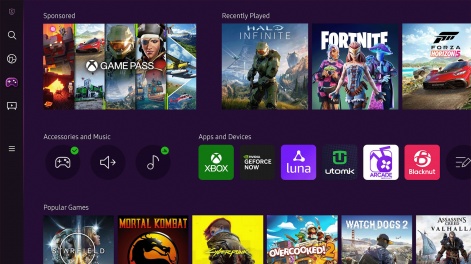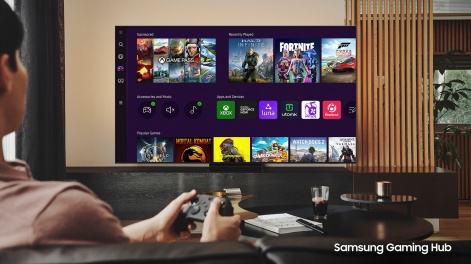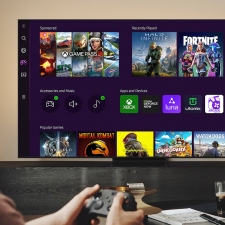Who needs a console humming beneath their TV or a PC in their bedroom when you can stream the latest games straight to your TV? That’s the premise of cloud gaming. It’s a sector where Samsung Gaming Hub is uniquely positioned thanks to Samsung’s dominance as a screen manufacturer.
Google Stadia may have retreated in January, but consoleless gaming via the cloud continues to be a hot topic. Microsoft’s first-quarter results showed an increase driven mainly by the Xbox Game Pass. Xbox Game Pass is one of the services available on the Samsung Gaming Hub, and this month it was officially joined there by two more in the form of Antstream Arcade and Blacknut.
The first anniversary of Samsung Gaming Hub is approaching at the end of this month (it launched on selected TVs on 30th June 2022). A couple of weeks ago, the company announced that gaming services Antstream Arcade and Blacknut are joining the platform, lining up alongside existing partners Xbox, NVIDIA GeForce NOW, Amazon Luna and Utomik.
That’s nearly 3,000 games available to play now, including arcade classics from Antstream Arcade – household names like Pac-Man, Galaga, and Double Dragon are on the list – and over 500 family titles from Blacknut. Each service needs its own subscription but comes with significant discounts through the Samsung Gaming Hub and, in the case of Blacknut, a trial period.
Exclusive interview about the state of cloud gaming on TV
PC Games Insider spoke to Samsung Electronics America’s Director of Product Management for Gaming twice this year to learn more. We first sat down with Mike Lucero at GDC in San Francisco for a demo of the Samsung Gaming Hub and then again in Seattle recently for an informal and exclusive chat about the company’s philosophy and ambitions.
Some of the conversation was super secret and still under embargo, so watch this space for more. Still, we were able to tease out more information about the platform’s most recent updates.
We’ll be interested to see people playing Pac-Man with the remote control, which is pretty nifty!Mike Lucero
Mike Lucero has been in the games industry for 25 years, was one of the founding members of the Xbox Live team, and also spent time at Twitch. “I was one of maybe five people at Microsoft who knew anything about broadband,” he jokes. “When they decided to put the Ethernet port in the back of the Xbox, they needed somebody that knew something about broadband.” Lucero has been at Samsung since January 2020.
PC Games Insider: What lessons has your team learned in the first year of Samsung Gaming Hub?
Mike Lucero: When we launched, we tried to be humble, and we remain humble. We have a long ways to go. But one important thing we saw right at the beginning was working with all our partners to ensure the performance was there.
In many ways, our partners are doing firsts on our platform. Like GeForce NOW did 4k on our platform. They realise that we’re a test bed for whether something will work or not. And obviously, we bring great business value because of our scale.
People have embraced both the breadth and depth of game-playing we and our partners offer. We’ve seen the diversity of that content appreciated by the different gaming communities. A lot of people like 10-foot gaming experiences on Xbox and GeForce NOW – it’s a triple-A, hardcore type of gaming, and players appreciate the latency. They really are surprised! “Oh my God, it IS like a console!” So we focused on the right things: gameplay performance and good content.

Samsung Gaming Hub has a user interface very much like a console. With game controllers that you just directly pair to your Samsung TV, it’s all things gaming in one place. And it has Twitch, YouTube, and Spotify all integrated. It puts everything together in one place, making it a native experience for people. But without the actual console!
Even for more casual games: one of our great partnerships is with Luna. And one of the deals with Luna – for their millions of Amazon Prime members – is they can get four free games per month, and that rotates. In February, they had Jackbox as the featured game, and people could play without a controller using their mobile devices. Not even just a virtual controller, but actually your phone, through the browser. We’re providing more ways to interact with the games.
Similarly, Blacknut has games you can play with the remote control. So we’ll be very interested to see people playing Pac-Man with the remote control, which is pretty nifty!
Can you tell us more about your thinking when it comes to playing games with a remote control?
There’s a huge swath of people that do not have game controllers. So bringing [alternatives] to them is important. It’s all about accessibility at the end of the day. Gaming is the most popular form of entertainment in the world. But there are still some people who don’t play games yet, and there are so many reasons for that. It could be the content, it could be the cost, it could be the method of interaction. We’re just trying to remove all these because we honestly think that almost everybody would enjoy playing games.
Titles like Galaga or Defender... while being very much part of our gaming history, are still a great test of skillsMike Lucero
Blacknut Games and Antstream Arcade are coming to the platform. What do they bring to the experience?
What I like about Blacknut is that there’s content there for every member of the family: Mom, Dad, kids, athletic daughters and sons, whomever. Less serious stuff for parents and kids, puzzles, and a lot of sports stuff. They’re also providing us with an exclusive title or two in the US.
Antstream is the retro arcade. We have had many chats with them over the last six months, and we realise that even hardcore gamers are as enthusiastic about retro games as casual gamers. Sure, they’re easier, more accessible, more approachable. But retro arcade games have two things about them.
Firstly, they’re very storied, you know? Titles like Galaga or Defender are all games we grew up with. And the other thing that makes them fun is that they often have leaderboards. While being very much part of our gaming history, they are still challenging, a great test of skills.
Streamers really leaned into leaderboards and created tournaments in the spirit of the arcades. Dive in, and reclaim your top spot!
You’ve got potentially thousands of games to play. How do you make sure you’re not chasing quantity over quality?
A big part of our value proposition is around content curation. First of all, our partners don’t necessarily compete with one another. I did a panel at CES and had Blacknut, Utomik and NVIDIA on stage. I was worried that they were going to have a dogfight up there! But they each go after someone very specific. So they’re not competing against each other, just trying to take advantage of our scale to reach their audiences. I have a lot of faith in their own curation. Their catalogues are not going for volume. They’re going for games that fit their images and their players.
The other thing is that we’re getting people excited about themes and supporting games around that. For example, if there’s a theme like a basketball or a hockey cup, we will do programming around that to make it fun and a chance to look at older games. Sometimes people have forgotten about a title, and we can use an opportunity to foreground it.

We have a decent recommendation engine. If you go into our game details page, you’ll find related titles. We try to surface that content so that it is exposed and in a contextually relevant way.
That works across services, so if I play games in Xbox Live, I might even see recommendations for games in Blacknut. Obviously, the partners want to promote their own content, but then they also get exposure this way – it’s a mixed blessing, reciprocal.
How are you tackling the technical challenges behind the scenes to ensure the quality of the gaming experience? Not everyone in the world has a fantastic broadband connection.
That’s probably the most important question. And I can be specific because of how dedicated our content streaming partners and our own engineers are to this. The core principle is that every millisecond matters, and we have to know if we can save a millisecond here or there – they all add up. If you’ve shaved off 10 milliseconds, that is perceptible.
On the TV side, we’ve done two-and-a-half things. First, we’ve reduced the latency between the Bluetooth controller, so when you push the button, we’ve taken some milliseconds out of that part of the journey.
Then, in the single game mode, we’ve removed 30% of the latency within the TV itself.
One fascinating thing [is] the importance of network prioritisation with the telcos. It’s important to get the game stream traffic to be prioritisedMike Lucero
The “half” that I refer to is on the back end when the signal comes in. The Xbox comes in at 1080, so we do 4k upscaling using AI upscaling to enhance the image and make it look more like 4k.
Meanwhile, our gaming partners have done two specific things. Remember, streaming has gotten a lot better since Stadia launched, which was almost four years ago!
One fascinating thing: I was talking to the Head of Product Management from NVIDIA at CES. And he was talking about the importance of network prioritisation with the telcos. It’s important to get the game stream traffic to be prioritised. All the data flowing through those is hugely important. So they’ve prioritised the traffic and done a good job of putting the servers where they need to be.
By the way, a trickier thing comes with wi-fi in the wild. I have five TVs running the Gaming Hub; they all work fine over wi-fi. One is very close to the hot spot and incredibly fine! And that’s what most people are like. But let’s say you’re in Florence, Italy, in a house from the 1400s – my friend there has to have it hard-wired through the wall.
Anyway, the second thing our partners have done: the optimisation itself of the actual infrastructure has gotten much better. The chips are faster; they’re more powerful. And that continues to happen. Because for this to thrive, the cost needs to keep coming down. That’s what’s going to make this scale.
If you’re [CEO of Microsoft Gaming] Phil Spencer, and you’re transforming the entire platform, making it one of your big bets, the costs need to keep coming down. This is important if things are going to scale up.
Without getting too technical, there’s a whole orchestration that goes on so that there are instances of games ready to fire up, and you don’t have to wait for it. The management of all that has gotten better and better over the years.
Samsung Gaming Hub was most recently at Summer Game Fest in Los Angeles last week with more games, screens and ways to play – Antstream Arcade and Blacknut were featured at the Samsung Gaming Hub booth, alongside Xbox, NVIDIA GeForce NOW, Amazon Luna and Utomik. Find out more about playing games on mobile at our partner site PocketGamer.biz and discover the convergence of entertainment technologies at BeyondGames.biz.

















